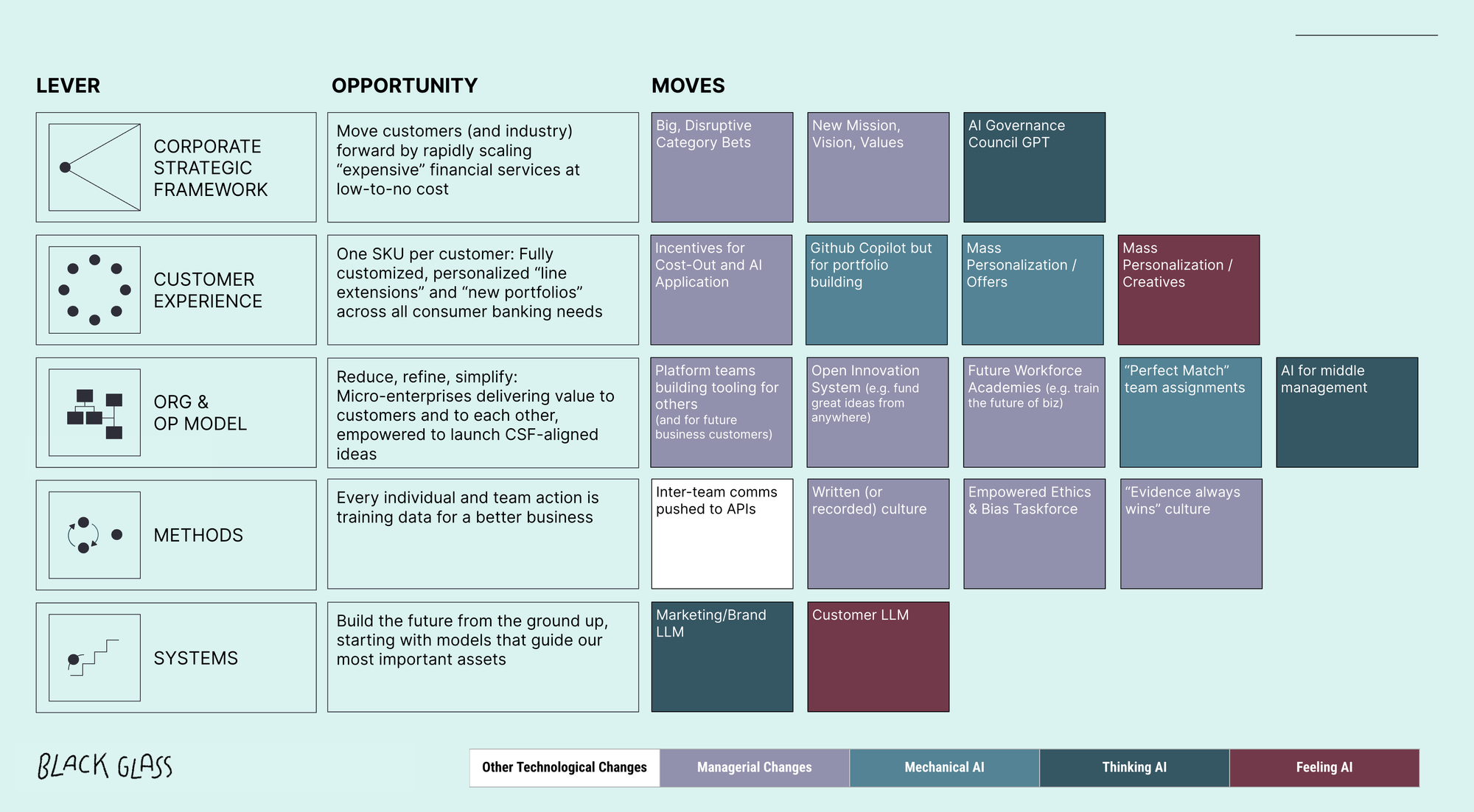Is AI just for banners and meeting notes?
A framework for applying AI everywhere within your org, and how to start thinking differently about its impact on your business

Most conversations these days around AI and Marketing orgs are either doom and gloom – “the robots are taking the jobs” – or uninspiring – “look at all of the banners we can make.” We want to push against this and think bigger and better: how can AI actually enable marketing organizations to operate better in the world?
Previously, we had introduced our own take on the “cascading choices” strategy framework (working title: CMO Map to Growth). In our version, each component defines, enables and evolves another. And this continues to happen in perpetuity with ongoing shifts constantly pushing the framework out of balance.

Now, let’s think about AI. We like to leverage the types of AI organized in The Journal of The Academy of Marketing Science which categorizes options based on the benefit it provides: Mechanical AI (standardization), Thinking (personalization) and Feeling AI (relationalization).
Put simply:
- Mechanical AI/Standardization allows marketers to automate things that would otherwise take too much time. The key here is to think beyond automating today’s processes, and to go deeper into things that would otherwise be impossible or impractical by relying only on human labor.
- Thinking AI/Personalization allows marketers to quickly analyze market trends and buyer preferences. Again, it’s important to not think linearly here but rather consider all of the places that models and algorithms can learn and build associations to help you get smarter and more in tune with your market.
- Feeling AI/Relationalization allows marketers to go a step deeper in their understanding of their customer – focused on the emotional side of the equation. Think beyond just customer journey to sentiments, preferences and attitudes both for existing and potential customers.
We applied this to the challenges that might face a financial services company in the years ahead, and we discovered a combination of powerful opportunities and two additional calls for change:
- Other Technological Changes: It’s likely that major moves in each area will require additional non-AI/ML tooling
- Managerial Changes: The management system of the firm will need to be adjusted to capture the value of other major moves
When we apply these five different kinds of moves (AI + Tech + Managerial) to the five layers of the choice cascade, we end up with some very clear moves for the organization to make. These categories don’t play out equally across the choice cascade, and are likely to change as new technologies are developed.

Corporate Strategic Framework (CSF)
The broader adoption of artificial intelligence in a large financial services firm would bring a shift in the fundamental strategy of the firm, with a push to move customers (and industry) forward by rapidly scaling expensive financial services at low-to-no cost. This is already happening in some firms – Betterment, SoFi, E*Trade – but something it could expand.
Thinking AI
Managerial Changes
Customer Experience
Today, large financial institutions market a small number of “products,” most of which have tightly controlled brands – think American Express’ Blue Cash/Gold/Platinum cards, or Bank of America’s Advantage Checking/Advantage Savings/Home Loans/Merrill Investing – surrounded by offers to incentivize switching or “stair stepping” to deeper customer relationships.
This is a simplified view, to be sure, but with the deeper inclusion of Gen AI/ML technologies into the business, they will be able to truly offer “one of one” products per customer, with fully customized, personalized “line extensions” and “new portfolios” across all consumer banking needs.
Mechanical AI
Feeling AI
Managerial Changes
Organizations/Op Model
In support of the expanding diversity of products and solutions delivered to customers, these firms will be able to – and in some ways required to! – radically reduce, refine, and simplify, with micro-enterprises delivering value to customers and to each other, empowered to launch ideas aligned to the revised CSF. Doing so will allow for more adaptivity, greater speed, and more comprehensive support for the big moves the firm would want to make.
Examples of this way of operating predate the recent explosion of AI, with notable cases at Haier and GE Aviation, and are gaining traction: see the recent developments at Bayer, where they’re working to reduce management layers and empower a network of accountable teams.
Mechanical AI
Thinking AI
Managerial Changes
Methods/Ways of Working
Active users of ChatGPT (and other embedded AI/ML-powered tools in systems like Miro, Descript, Loom, Zoom, Canva, and others!) already know that ways of working are rapidly changing for individual contributors and managers alike. But the big shift in ways of working will be driven by the changes listed above. It’s not just about how we get our work done, it’s about using every individual and team action as training data for a better business.
Other Technological Changes
Managerial Changes
Systems
Lastly and perhaps most obviously, new systems will need to be built for the future from the ground up, starting with models that guide the firm’s most important assets.
For example: research tells us that Customer Assets and Brand Assets are major drivers of revenue (e.g. increasing customer loyalty from 80% to 90% doubles the long-term value of a company), so it’s only logical that the firm would work to build its own large language models (LLMs) to support relationship deepening. In our view, that will only happen when all of the elements described above are brought to life.
Thinking AI
Feeling AI
Hopefully this has given you some inspiration to think bigger (and more positively) when someone asks you about how your role, team, org, etc, is ‘adapting to AI’. The possibilities are endless - and ever changing - so it’s critical to not lose sight of the future while trying to solve for today. Continuously ask yourself ‘how can AI improve this (task, process, etc) and soon you will be able to optimize your time to focus on the things that truly drive impact, growth and balance for both you and your business.





